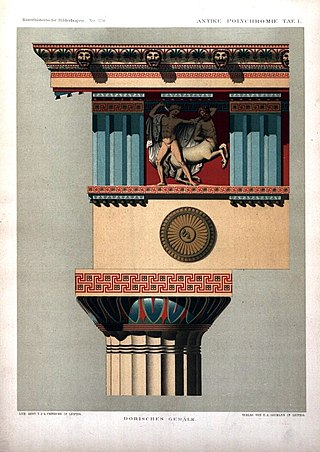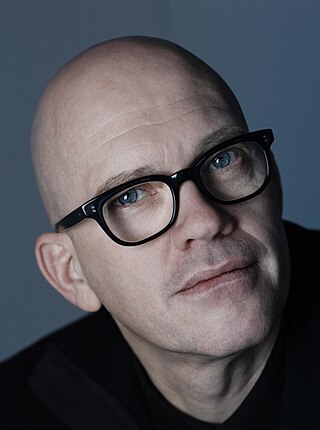
Gerrit Rietveld was a Dutch furniture designer and architect.

Furniture refers to objects intended to support various human activities such as seating, eating (tables), storing items, working, and sleeping. Furniture is also used to hold objects at a convenient height for work, or to store things. Furniture can be a product of design and can be considered a form of decorative art. In addition to furniture's functional role, it can serve a symbolic or religious purpose. It can be made from a vast multitude of materials, including metal, plastic, and wood. Furniture can be made using a variety of woodworking joints which often reflects the local culture.

Jugendstil was an artistic movement, particularly in the decorative arts, that was influential primarily in Germany and elsewhere in Europe to a lesser extent from about 1895 until about 1910. It was the German counterpart of Art Nouveau. The members of the movement were reacting against the historicism and neo-classicism of the official art and architecture academies. It took its name from the art journal Jugend, founded by the German artist Georg Hirth. It was especially active in the graphic arts and interior decoration.

De Stijl, also known as Neoplasticism, was a Dutch art movement founded in 1917 in Leiden. De Stijl consisted of artists and architects. In a more narrow sense, the term De Stijl is used to refer to a body of work from 1917 to 1931 founded in the Netherlands. Proponents of De Stijl advocated pure abstraction and universality by a reduction to the essentials of form and colour. They simplified visual compositions to vertical and horizontal, using only black, white and primary colors.

Polychrome is the "practice of decorating architectural elements, sculpture, etc., in a variety of colors." The term is used to refer to certain styles of architecture, pottery, or sculpture in multiple colors.

The Rietveld Schröder House in Utrecht was built in 1924 by Dutch architect Gerrit Rietveld for Mrs. Truus Schröder-Schräder and her three children.
Events from the year 1923 in art.

Municipal Museum Boijmans Van Beuningen is an art museum in Rotterdam in the Netherlands. The name of the museum is derived from the two most important collectors of Frans Jacob Otto Boijmans and Daniël George van Beuningen. It is located at the Museumpark in the district Rotterdam Centrum, close to the Kunsthal and the Natural History Museum.

Modern furniture refers to furniture produced from the late 19th century through the present that is influenced by modernism. Post-World War II ideals of cutting excess, commodification, and practicality of materials in design heavily influenced the aesthetic of the furniture. It was a tremendous departure from all furniture design that had gone before it. There was an opposition to the decorative arts, which included Art Nouveau, Neoclassical, and Victorian styles. Dark or gilded carved wood and richly patterned fabrics gave way to the glittering simplicity and geometry of polished metal. The forms of furniture evolved from visually heavy to visually light. This shift from decorative to minimalist principles of design can be attributed to the introduction of new technology, changes in philosophy, and the influences of the principles of architecture. As Philip Johnson, the founder of the Department of Architecture and Design at the Museum of Modern Art articulates:
"Today industrial design is functionally motivated and follows the same principles as modern architecture: machine-like simplicity, smoothness of surface, avoidance of ornament ... It is perhaps the most fundamental contrast between the two periods of design that in 1900 the Decorative Arts possessed ..."

Mathilda (Til) Brugman was a Dutch author, poet, translator, and linguist.
Robert van 't Hoff, born Robbert van 't Hoff, was a Dutch architect and furniture designer. His Villa Henny, designed in 1914, was one of the earliest modernist houses and one of the first to be built out of reinforced concrete. From 1917 he was an influential member of the De Stijl movement.

A Rietveld joint, also called a Cartesian node in furniture-making, is an overlapping joint of three battens in the three orthogonal directions.

Willem Hendrik Gispen was a Dutch industrial designer, best known for his Giso lamps and serially produced functionalist steel-tube furniture.

Gijs Bakker is a Dutch jewellery and industrial-designer, educated at the Gerrit Rietveld Academie in Amsterdam, the Netherlands and the Konstfackskolan in Stockholm, Sweden.

Scott Burton was an American sculptor and performance artist best known for his large-scale furniture sculptures in granite and bronze.

The Zig Zag-chair is a chair designed by Gerrit Rietveld sometime between 1930 and 1934.

Henk Stallinga is a Dutch multidisciplinary contemporary artist based in Amsterdam.

Joris Hendricus Laarman is a Dutch designer, artist, furniture maker, and entrepreneur best known for his experimental designs inspired by emerging technologies. Laarman's projects are a blend of technology, art and design, with a focus on the potential of 3D printing. Major projects include 3D-printed stainless-steel bridge in Amsterdam, which showcases the potential for creating adaptive, lightweight, and uniquely designed structures using 3D printing. Laarman has also explored furniture design, including the 'Bone' series which used 3D-optimization software to achieve optimal construction. The designer's work often evokes a futuristic feel while nodding to historical art movements, exemplified by pieces like his "Digital Matter" series. When Laarman speaks about his work he discussed the implications and responsibilities that come with breakthrough technologies.
Iris Eichenberg is a German post-war, contemporary artist, metalsmith, and educator. She is head of the Metalsmithing Department at the Cranbook Academy of Art.
Artifort is a design furniture manufacturer. It was founded in 1890 by Jules Wagemans in Maastricht, The Netherlands. Since 1998, Artifort is a Lande Group brand. The headquarters is located in Schijndel. The furniture is made in-house at the production-units in Schijndel, Lanaken, Belgium and Bursa, Turkey. Artifort furniture is known for its organic shapes, upholstery and is sold worldwide both in the contract and residential market.
















